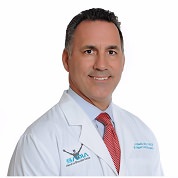Hand and Upper Limb Surgeon Dr. Alejandro Badia acknowledges May as National Arthritis Awareness Month, offers tips to cut risks for disease affecting millions.
MIAMI (PRWEB) April 09, 2019
Nearly 100 percent of former football players will have signs of osteoarthritis – the most common form of arthritis — in one or more of their joints, says orthopedic surgeon Alejandro Badia MD, an expert in the treatment of diseases of the upper limbs and joints, including disorders related to sports.
“That’s because previous traumatic injury to joints – common in football — plays a role in later development of the disease,” says Dr. Badia, founder and chief medical officer of the Badia Hand to Shoulder Center and OrthoNOW®. He is especially noted for treating joint disorders, including arthritis, in the upper limbs of professional, amateur and recreational athletes. Dr. Badia cautions, however, not to think of arthritis simply as one disease.
“The term actually applies to more than 100 different joint-related conditions, and multiple causative factors, including sports injuries and other kinds of trauma, are involved,” says Dr. Badia, who himself suffers from arthritis in the knee and calls arthritis the leading cause of physical disability in the United States.
Dr. Badia’s comments come as a reminder that May is National Arthritis Awareness Month.
Twenty-seven million Americans have symptoms of osteoarthritis involving one or more joints. In fact, approximately 70 percent of people age 65 and over would likely show some evidence of osteoarthritis if they were X-rayed, but not all are symptomatic.
Often called the “wear-and-tear” disease, osteoarthritis develops over time due to a breakdown of joint cartilage, the hard tissue at the end of bones that form a joint, Dr. Badia says. “Cartilage serves as a shock absorber for joints. When it wears away, bones grind on bones, and the result is pain, stiffness, swelling and loss of joint function.”
Another 1.5 million or more people in the United States suffer from rheumatoid arthritis – the second most common form of arthritis.
Rheumatoid arthritis is an autoimmune disorder that inflames joints by causing a person’s own white blood cells to attack the synovium, the soft tissue that nourishes and lubricates joint cartilage.
Although advancing age is a major factor for developing arthritis, Dr. Badia advises that the joint disorder is not limited to the elderly.
“The general misconception is that arthritis just appears in older individuals and primarily impacts the knees and hips. Not true. The disease can occur at almost any age and affect the upper back and neck, shoulders, elbows, wrists and hands, as well as lower limbs,” he says.
Extensive physical, repetitive activity on the job; previous injuries to joints; family history of joint disease; genetics; obesity; diet – even smoking – all play roles in arthritis, Dr. Badia says.
Arthritis may develop in almost any joint, but, in the hands, arms or shoulders, the disease can prove truly limiting, impacting a person’s ability to perform common daily tasks – even such simple functions as tying a shoe or opening and tightening a jar lid.
Particularly susceptible to the disorder are wrist joints and the more than 25 joints in the hand, Dr. Badia says. Rheumatoid arthritis can affect the large and middle knuckles of the fingers and, in advanced stages, lead to both hand and wrist deformities. Osteoarthritis may result in formation of nodes and bony lumps on or near finger joints.
Standard treatments for relieving arthritis symptoms include applying moist heat or ice to affected joints, taking over-the-counter non-steroidal anti-inflammatory drugs or prescribed medications, resting joints, undergoing physical therapy and/or performing range-of-motion exercises.
However, as the disease progresses, techniques to debride – clean out — a diseased joint or even replace it with a prosthesis might be necessary, Dr. Badia says.
Surgery may be required to realign and restore function to a hand deformed by arthritis. Arthritis in the shoulder usually will develop where collarbone meets the tip of the shoulder blade. Should nonsurgical options fail, treatment of arthritis in this area of the shoulder might require resection arthroplasty in which a small end-piece of collarbone is removed, Dr. Badia says. For arthritis in the shoulder’s ball-and-socket (glenohumeral) joint, surgical approaches can include standard total shoulder replacement, hemiarthroplasty (half-joint repair), joint resurfacing, and even “reverse” shoulder arthroplasty.
Some specialists are turning to Orthobiologics – the harnessing the power of a person’s own biologic substances, including blood platelets (PRP therapy) and adult (mesenchymal) stem cells – as an option for treating some cases of arthritis;
“Arthritis is not curable. That’s why early treatment is so essential to slowing its progression and avoiding extensive, restorative procedures,” says Dr. Badia, who served as the Orthopedic Medical Honoree for the 2018 Walk to Cure Arthritis in Miami.
Although age and genetic makeup are unavoidable, many people can prevent arthritic pain and loss of function with lifestyle changes. Dr. Badia offers these tips:
- Follow a healthy diet and maintain normal weight for your height, age and frame. That means shedding the extra pounds.
- Exercise regularly.
- Limit stress on joints. Avoid overexertion, awkward positions, improper posture or repetitive use of joints.
- Balance daily activities with needed rest.
- Control blood sugar. The Arthritis Foundation says diabetes can trigger the kind of inflammation linked to cartilage loss.
Bio: Alejandro Badia, MD, FACS, internationally renowned hand and upper-limb surgeon and founder of Badia Hand to Shoulder Center and OrthoNOW®, a walk-in orthopedic care clinic. He is a member the American Society for Surgery of the Hand, American Association for Hand Surgery and the American Academy of Orthopedic Surgeons. He is a specialist in treating all problems related to the hand and upper extremity including trauma, sports injury, joint reconstruction, nerve injuries and arthroscopic surgeries. http://www.OrthoNOWcare.com, http://www.drbadia.com

